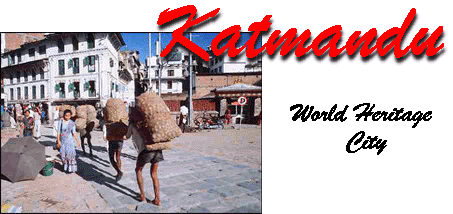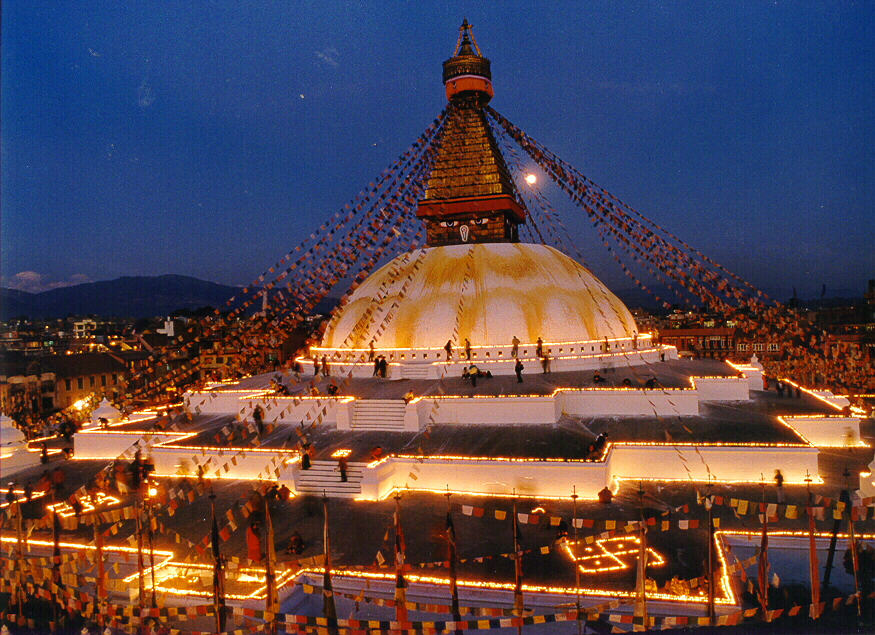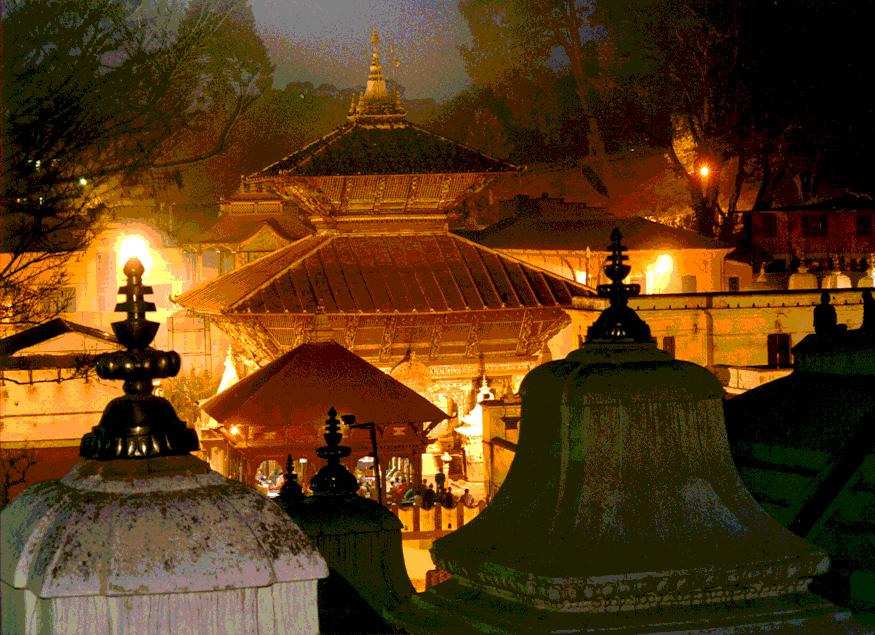 <CLICK HERE FOR MAP>
<CLICK HERE FOR MAP>
| A very old Hindu text has described
Kathmandu as the land of gods surrounded by beautiful mountains around.
Some two hundred years ago a western Visitor wrote that there were as many
temples as there were houses and many idols as there were people. In fact
Kathmandu boasts one of the largest congregations of magnificent historical
monuments and shrines ever built.Duly recognized as a world Heritage Site
by UNESCO- this particular area best known as Kathmandu Durbar Square lies
in the heart of this city. Locally also called as Hanuman Dhoka Palace
Square-an ancient seat of the Nepalese Royalty.
The entire Palace Complex here is
named after a monkey god called Hanuman. One can see a huge stone statue
of Hanuman painted all red right next to the main entrance ( the golden
gate) of the palace. Hanuman here is regarded as a powerful protector of
the entire Durbar Square.
Generally a holy memorial site Stoup represents a typical Buddhist architecture. Its main feature the white dome is identified with a spotless pure jewel of Nirvana and a thirteen tiered golden spire in conical shape surmounted on the dome. Underneath this towering structure are a pair of all seeing eyes of Buddha painted on all four sides of the Stupa. The Stupa of Swayambhunath stands on a typically stylized lotus mandala base-a long time ago believed to have originated from a legendary lake of Kathmandu Valley. As the ancient legend goes
Kathmandu Valley was a lake a long time ago. Right in the centre
of this lake was a full blown lotus with the divine light a top. When Maha
Manjushri a saint from China heard about this he came rushing all the way
from China to the Valley. He cut through the southern wall hill of the
valley with his divine sword. The cleft made by the sword immediately drained
the entire lake water making the valley floor open for a close up view
of the divine lotus light.
Other important things to be
seen here include a magnificent two tiered golden temple dedicated to Harati.
She is the grand mother deity of children and small pox who was said to
be the Ogress until Lord Buddha converted her to be the great caretaker
of the children.
Important days to visit this holy site: 1. Buddha Purnima, the birth day
of Lord Buddha which fails on the full moon day of Baishak (April-May)
|
 One
of the oldest and the biggest Buddhist monuments ever built in Nepal, Boudhanath
is an imposing structure standing some 36 meters. The Stupa stands on the
massive three level mandala style Platforms surrounded by colourful private
family houses.
One
of the oldest and the biggest Buddhist monuments ever built in Nepal, Boudhanath
is an imposing structure standing some 36 meters. The Stupa stands on the
massive three level mandala style Platforms surrounded by colourful private
family houses.
The basic feature of this great
stupa is very much like that of Swayambhunath stupa except its finial displaying.
It is much bigger than Swayambhu stupa and lies on the valley floor whereas
the former one stands on the hill top. This stupa is said to have
been built in 5th century A. D. The site is considered very much like mecca
for the Tibetan Buddhists and every year tens of thousands of pilgrims
from all over the Himalayan region visit the stupa.
According to a very popular
legend long time ago the kingdom of Kathmandu was under terrifying draught.
King Dharma Deva was very worried. An astrologer advised him that only
the sacrifice of an ideal man with 32 virtues in front of the dry royal
water spout could make the rain fall in the country. And in the following
night he commanded his son to go to the dry water spout inside the royal
palace compound at mid night and behead the person shrouded in white robe
without looking at him. The Prince obeyed his father but to his great horror
only to find it was none other than his own father.
In order to atone the big
sin and in removal the prince said to have built this great stupa. As an
entrepot of ancient Nepal-Tibet trade rout, the site is popularly frequented
by Tibetan visitors.
During Lhosar festival the pilgrims
worship the Buddhist deities, light the increase and butter lamp day and
night.
Every twelve year a special
ceremony is observed with great gusto and ferror . During that time they
dance, play musical instruments, chant and hymns.
 Pasupatinath
is considered one of the holiest shrines of all the Hindu temples. The
temple has remained the presiding deity of ruling Nepalese Royalty.
Located on the banks of the Bagmati river, this two tiered magnificent
golden temple with four triple silver doorways is unique example of the
Nepalese temple architecture. It is one of the largest Hindu temple complex
in'South Asia with hundreds of Shiva lingams, shrines icons of various
Hindu god and goddess insides. This temple site occupies an area of 281
hecters in total. The main entrance of this temple is in the western side
facing a small street of Deopatan market. As nonHindus are not allowed
to enter this temple courtyard. They are advised to go on the other side
of the river in the East to have a glimpse of the temple complex. In the
middle of the spring (Feb.March) every year there occurs a festival called
Shivaratri. The world Shivaratri means the holy night of Lord Shiva. On
this day many devotees visit the Pashupati Nath temple and make the ceremonial
fire. Most of the devotees spend the night offering prayers to Shiva. This
festival attracts tens of thousand of pilgrims from India besides the locals.
Historically pre-Chistian era this temple seems to have its origin away
back to the early Kirat period. Stone sculptures found in the vicinity
support the antiquity of this place. This holy site is 6 k.m. east oil
down town Kathmandu. Regular bus and taxi services are easily available
from a city points.
Pasupatinath
is considered one of the holiest shrines of all the Hindu temples. The
temple has remained the presiding deity of ruling Nepalese Royalty.
Located on the banks of the Bagmati river, this two tiered magnificent
golden temple with four triple silver doorways is unique example of the
Nepalese temple architecture. It is one of the largest Hindu temple complex
in'South Asia with hundreds of Shiva lingams, shrines icons of various
Hindu god and goddess insides. This temple site occupies an area of 281
hecters in total. The main entrance of this temple is in the western side
facing a small street of Deopatan market. As nonHindus are not allowed
to enter this temple courtyard. They are advised to go on the other side
of the river in the East to have a glimpse of the temple complex. In the
middle of the spring (Feb.March) every year there occurs a festival called
Shivaratri. The world Shivaratri means the holy night of Lord Shiva. On
this day many devotees visit the Pashupati Nath temple and make the ceremonial
fire. Most of the devotees spend the night offering prayers to Shiva. This
festival attracts tens of thousand of pilgrims from India besides the locals.
Historically pre-Chistian era this temple seems to have its origin away
back to the early Kirat period. Stone sculptures found in the vicinity
support the antiquity of this place. This holy site is 6 k.m. east oil
down town Kathmandu. Regular bus and taxi services are easily available
from a city points.